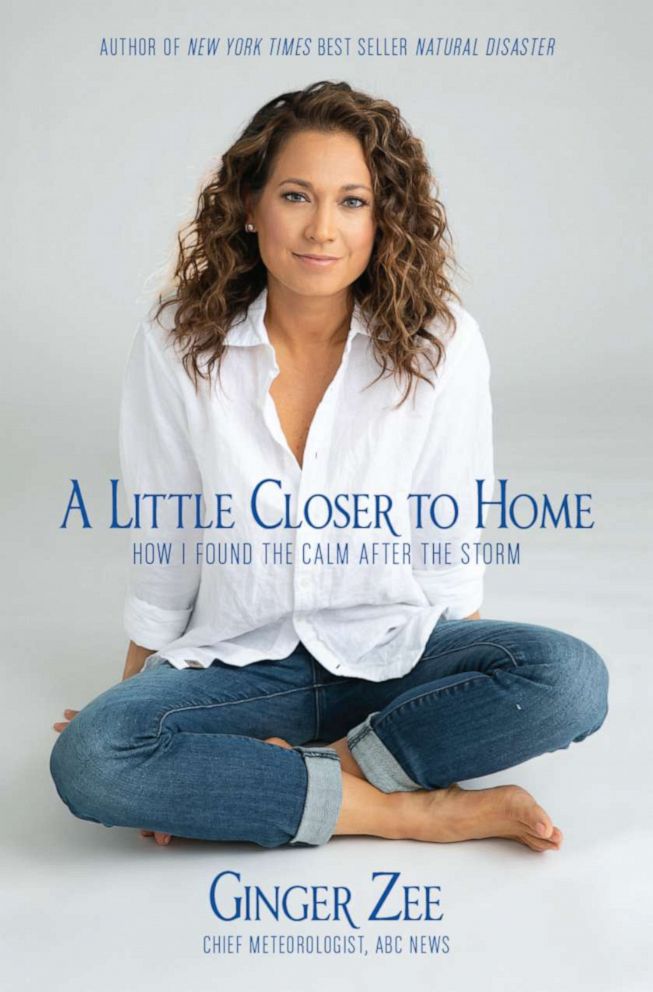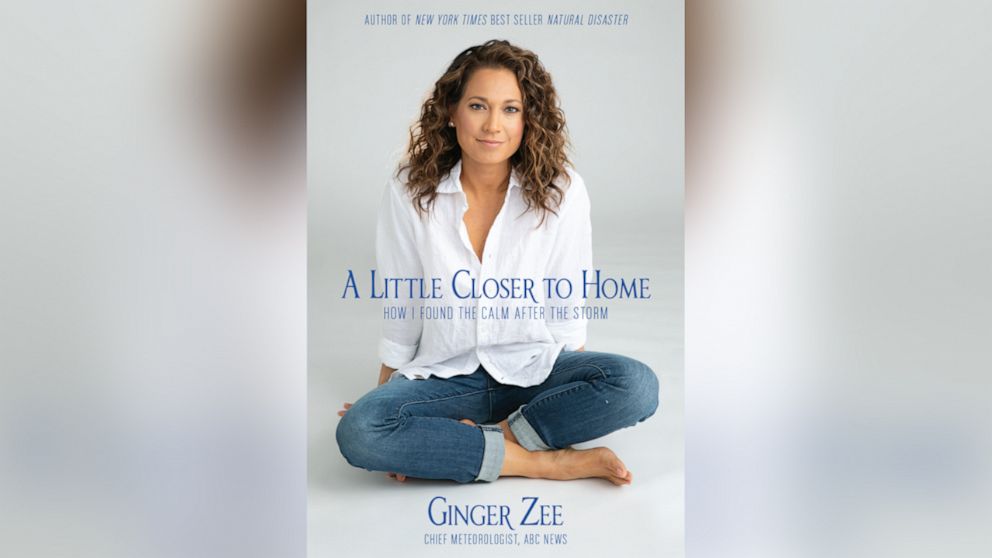Ginger Zee is taking readers on her journey of self discovery in a new memoir.
In her new memoir, "A Little Closer to Home: How I Found the Calm After the Storm," which is a follow-up to her first book, "Natural Disaster," the ABC News chief meteorologist dives into conversations about mental health by opening up about her own life experiences.

"The second book came because after the first, I was flabbergasted at the response that I got. I still, to this day, I'll have them in my direct messages that say, 'You saved my life.' When you hear that from someone, I think it's now my responsibility to keep bringing people information," Zee said.
In "A Little Closer to Home," Zee touches on her childhood, her ongoing struggles with crippling depression, suicide attempts and many other experiences that she hopes helps readers who are going through similar experiences she went through.
"We all have trauma. Every single one of us has lived through and you can't compare," she said. "My trauma was important because it sets the tone of what trauma might look like, what it might feel like, what we do have in common."
"That's what this book really is about," Zee added. "It's not only how to uncover -- and I describe it like a wound that I was very good at just kind of kicking some dirt and pretending it never happened and running down the road as fast as I could. And this book is the release, the opening up of the scab of the wound and saying, 'I'm ready to clean it out. Finally.' I want everybody to be able to do that without shame."
"A Little Closer to Home" will be available wherever books are sold starting Tuesday, Jan. 11.
Read an excerpt below and pre-order a copy:

'A Little Closer to Home: How I Found the Calm After the Storm' by Ginger Zee
By clicking on this shopping link, visitors will leave Goodmorningamerica.com. These e-commerce sites are operated under different terms and privacy policies than Goodmorningamerica.com. ABC will receive a commission for purchases made through these links
- $24.83
- $26.99
*****
INTRODUCTION
I started writing this chapter well before we all had to get used to wearing masks because of COVID-19. The "mask" I am referring to in this chapter is not the coronavirus-prevention mask that became so oddly political, but rather the mask of our facial expressions (often smiling when we’re not at all content) that we all wear at times to cover how we truly feel.
On August 31, 2020, I saw a Facebook post from our female meteorologist group: TEXAS FORECASTER, "A SMILE AS BIG AS TEXAS" suddenly dies was the headline.
Another broadcast meteorologist had died by suicide. I say another because we have lost several in the last few years. I can’t say with confidence that there is a propensity for folks in broadcast meteorology to take their own lives due to hours, PTSD from storms, or just overall rejection and lack of self-worth in this business. I can’t say that with stats, but there does seem to be an anecdotal correlation.
Under the image of Kelly Plasker, a morning meteorologist at the NBC affiliate in Lubbock, Texas, the messages with heart emojis and prayer hands filled the comments section. They spoke of the profound loss she had experienced when her teenage son had died by suicide just two years before. How she had bravely suffered through it all with a smile. And so many of the comments said: You would never know that under that brilliant smile there was such pain.
Those comments made me angry.
Really? At this point in our world, we don’t know that people who are suffering use a smile to cover their pain? C’mon.
I think we should all learn from these clichés and realize that that smile, that broad, unwavering smile, is often the calling card that something is wrong. I know it always was for me. The obsession with happiness or the expectation that happiness must rule our lives is a major problem.
I love leafing through my oma’s photos from the Netherlands. The square black-and-white photos feature my grandmother in her late twenties right after World War II, gorgeous and natural, far from skinny, and unquestionably confident. She and the people around her were not posing with fake smiles. Even at the beach, with their arms around each other in the late 1940s and early 1950s, they are at best, “smizing.”
In my most Carrie Bradshaw moment of this book, I couldn’t help but wonder, when did the smile become the default expression? When did we societally start having to smile in photos? When did we have to smile when we didn’t feel like it?
In my quick research, there seems to be some explanation for the smile as a default in photographs starting with technological advancements in the late 1800s (the photo could be taken faster, so holding a smile wasn’t as tedious). A Time magazine article theorized that in the early days of photography, people didn’t smile because they were trying to re-create a painted portrait in which subjects rarely smiled.
In fact, a big smile in a photo or painting during that period was an indication that the subject might be mentally unstable, drunk, or simply a clown. Isn’t that fascinating? At the time, a smile was interpreted as a potential problem. And now, when we see a photo of someone who isn’t smiling, we assume something must be wrong.
When did a smile go from psychologically off to mainstream? It seems this may have been an American-made phenomenon thanks to a post-WWII 1950s Kodak advertising campaign featuring cameras, film, and lots of photos of people sporting wide smiles.
Photography quickly became part of happy times and special occasions, so the smile evolved as an expected element. In the Time article, a study of yearbook photos clearly shows this evolution of style in portrait photos from serious expressions to smiling faces. These days, when we’re all photographers and can take high-quality images with our phones at no expense, a perfect smile isn’t quite as important. My favorite shots remind me of Oma’s images from years ago!
We all wear a smile, but that’s not most people’s default expression. Some of us have perfected the art of not emoting what we truly feel. I think this mask is one of the widely accepted reasons that mental health problems have attracted such a stigma, and the subject of mental health itself has taken so long to get the attention it deserves. And perhaps, as Whippman found, has itself contributed to some mental health issues.
My smile and I have a long history. I was a competitive cheerleader in high school, and smiling was one of the most crucial parts of the uniform. In my case, it meshed perfectly with my anorexia and depression. Even if we were injured or slapped in the face at cheer practice, running up and down the stairs in a heat index of one hundred, we were instructed to smile. Even after one of the girls threw up, she was told to get back out there and smile through her nausea.
That’s what life feels like to me sometimes—running with a smile on my face, crying and throwing up at the same time. And to some extent that’s okay. I think it’s important to be a positive force in the world, but not to the point where I’m hiding myself behind the mask.
And there were too many times when that smile got bigger as I got sadder. I didn’t feel comfortable talking to other people and never wanted to share the madness I felt inside. The stigma of mental illness had a lot to do with that. To be vulnerable and share my imperfections was an impossibility while I was in my twenties. The last thing I would ever do was tell people I had attempted suicide or that I was raped or that I had an abortion. If I smiled, they might never even suspect it.
In the early 2000s, had I been transparent with any of that, I think it would have had negative professional implications. Psychotropic medication was not as accepted then as it is today. If you think about it, we are just now to the point where people can say "I have depression or anxiety" without radical reactions. Therapy and the use of medication have become more widespread and accepted.
The moment I mention my hospitalization, though, people’s ears perk up and their eyes widen—the action I took still has a stigma. And that’s what needs to change. Like drug and alcohol rehabilitation, mental rehabilitation should be looked at through the same lens. Disease. Treatment. Thriving.
*****
From A LITTLE CLOSER TO HOME: How I Found The Calm After The Storm by Ginger Zee (Hyperion Avenue, 2022)




